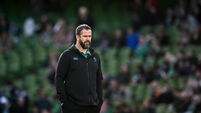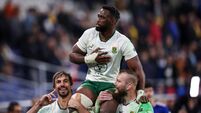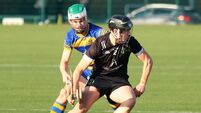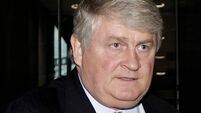Donal Lenihan: What, if anything, did Andy Farrell learn from Georgia win?
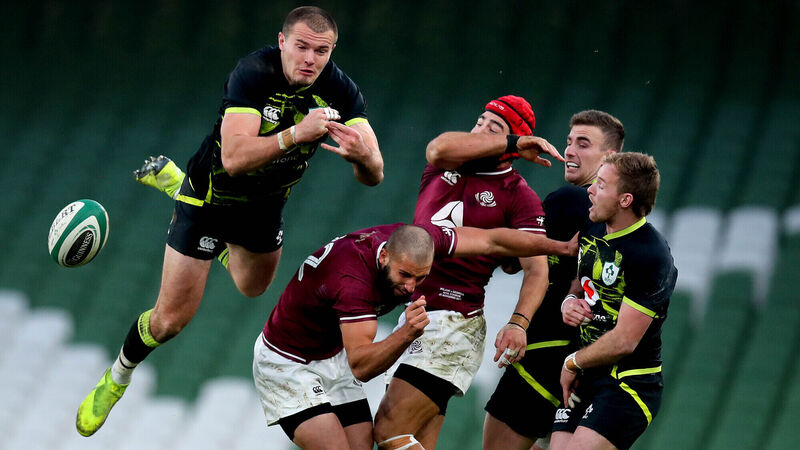
Ireland’s Jacob Stockdale goes high over Georgia’s Demur Tapladze and Akaki Tabutsadze during the Autumn Nations Cup game at the Aviva. Picture: Ryan Byrne
On a perfect day for rugby, a winning margin of 13 points against a side who had only managed a single try and seven points in total in their three autumn Tests against Scotland, England and Wales coming into this one must be seen as a disappointment from an Irish perspective.
After a promising opening half, full of attacking intent, two quality tries and a third disallowed for a marginal forward pass, one was entitled to assume that Ireland would kick on after the break against a Georgian squad in a rebuilding phase since losing a number of experienced campaigners after the 2019 World Cup in Japan.
It was the Georgians however who emerged with the moral victory in that second period, restricting Ireland to a three-point return from a Ross Byrne penalty on the back of a superb defensive performance and some flashes of inspiration in attack.
So what, if anything, did Andy Farrell learn from that? One of the main focus points for the head coach and his management team surrounded the manner with which Ulster No 10 Billy Burns, starting an international for the first time after promising cameo appearances off the bench against Wales and England, would steer the team from the outset.
Burns represents the fifth pretender to challenge Johnny Sexton for the starting jersey in the last four years, following in the footsteps of Paddy Jackson, Joey Carbery, Jack Carty and Byrne.
It was something that Burns, who qualifies to represent Ireland courtesy of his Cork-born grandfather, must have been acutely aware of coming into this game.
In that context, the opening quarter couldn’t have gone much better for Burns with a super try after only nine minutes which following some clever play by him in the build up. He attacked the gain line, displayed a beautiful array of passes off both hands and varied his game well with some clever chips in behind the Georgian midfield creating havoc early on.
Given the impact Burns was having, it was hugely disappointing to see him forced off five minutes after the restart with what looked like a groin injury that must leave him a doubt for Saturday’s final outing of the series against Scotland.
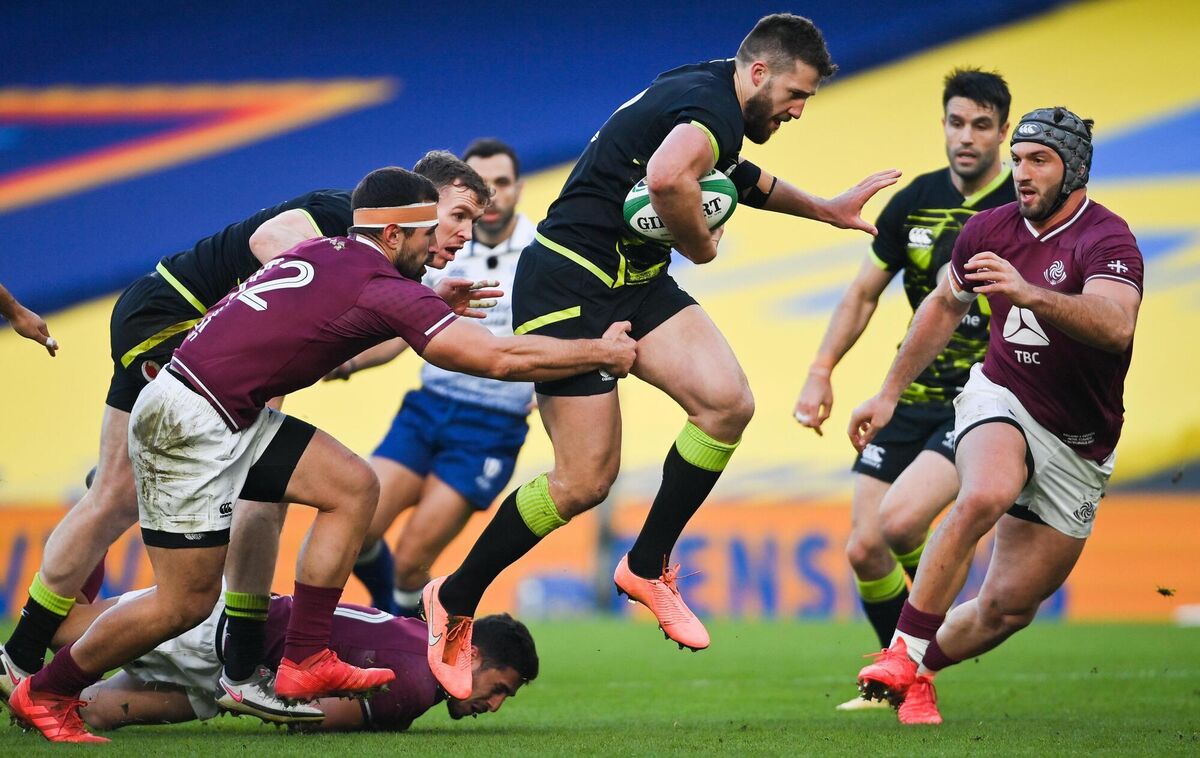
It certainly aided Burns’s cause that the quality of Ireland’s recycling in the opening half was on a different planet to what the forwards were able to engineer in Twickenham.
This time around the majority of rucks were delivering ball in less than three seconds from the point of contact leaving the Georgian defence with little or no time to reset.
In conditions perfect for handling, Ireland’s passing was crisp and sharp as the attack looked to put far more width on their game. Jacob Stockdale unleashed two superb 20 metre passes, one off his left hand which created a smashing try for Hugo Keenan, the second off his right adjudged to have been forward that denied Stuart McCluskey his moment of glory.
Sadly that was about as good as it got. Ireland rarely threatened after Burns left the field as the second half descended into a disjointed, stop-start affair which suited the visitors.
It didn’t help that every scrum ended in a penalty, evenly distributed by the fussy French referee Mathieu Raynal at four apiece.
That said, Georgia deserve a lot of credit for their ability to stress the Irish defence off the limited attacking opportunities that came their way, not least for their excellent try in that opening half from powerful centre Giorgio Kveseladze.
With Jacob Stockdale restored to full back after his try scoring effort off the bench against England last time out, his task was to show that he is adapting to the demands of covering the backfield with No 15 on his back.
His attacking prowess is well established at this stage, it’s his ability to cope on the other side of the ball that will dictate if he starts, and in what position, when the Six Nations rolls around again in February.
From that perspective, and with Georgia failing to test the backfield, Farrell will be no wiser on that front after this.
Tadhg Beirne had already racked up two excellent performances in the second row against Italy and France in the rescheduled Six Nations games in October but the focus on this occasion was set firmly on his ability to influence the game from the back-row.
On that front he did not disappoint with another highly effective effort. His ball-winning capacity in a vastly improved lineout showing will have been noted as will his work on the deck in generating turnovers.
The main purpose of this exercise was in finetuning the selection for the Nations Cup play-off against Scotland on Saturday which will not only be a pivotal game before the Six Nations in February but will also serve as a barometer as to how far Ireland have travelled since Farrell took over.
After a promising start, this contest will have left Farrell with more questions than answers. Scotland have improved greatly since they opened last seasons Six Nations campaign here at the Aviva and, on this showing, will fancy their chances of creating further headaches for Farrell next weekend.



